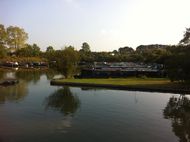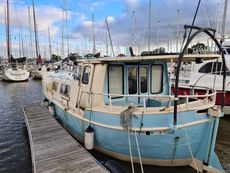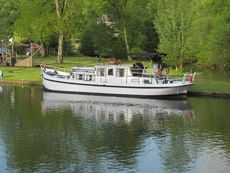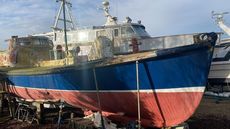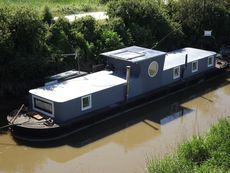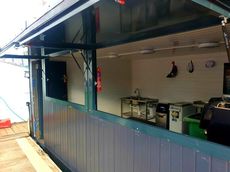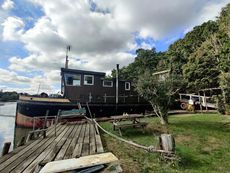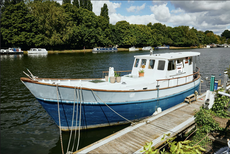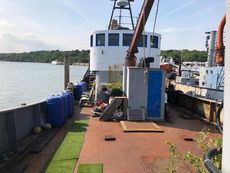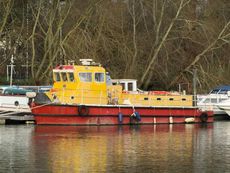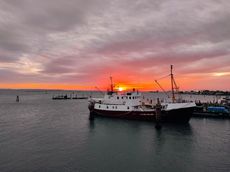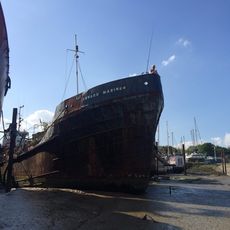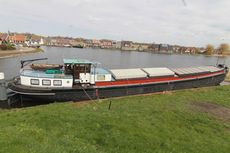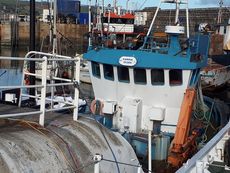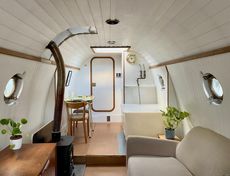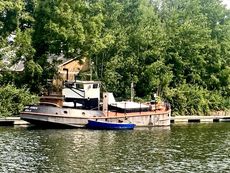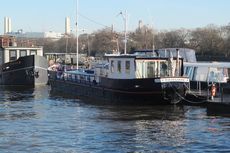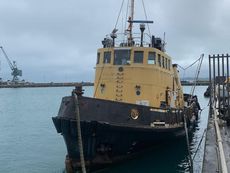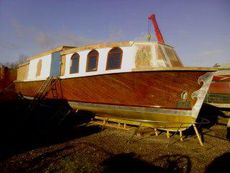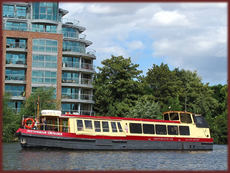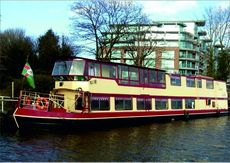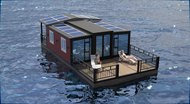Orcades is a 9.1m P&O Liner Lifeboat Conversion. With recent updates throughout, Orcades is perfect for one or two.
She has an incredible history, much of it documented in a large box of memorabilia and paperwork. Now, she's one of the most characterful boats around.
Currently situated in Chichester Harbour, she's been lifted, antifouled, new anodes and ready to go.
She has a Perkins D6 engine, galley with fridge, microwave, hot water, and free standing mini hob.
A diesel air heater is fitted, but needs fixing or replacing. There's a multi-fuel stove which is... read more
| Year: | 1948 |
| Length: | 9.10m |
| Location: | Itchenor West Sussex UK |
| Price: | £25,000 |
View Details | |
Description
Turning heads everywhere she passes by! But After many interesting years with trips throug several European countries, we are selling our KLENKES for health reasons and with a heavy heart.
The KLENKES is a converted Dutch Barge, whit lots of character and even more history. Tis Ship makes a brilliant „pied-a-terrethe“ or a cruising Ship with perfect size for the European Waterways.
With the two Steering stations (in- and outside) makes navigation easy.
You can walk on the “Gangway” around, without worrying to fell into water.
A large aft terrace (fl... read more
| Year: | 1920 |
| Length: | 16.27m |
| Location: | Mulhouse Port Alsace France |
| Price: | €98,000 Tax Paid |
View Details | |
Barnet 52 Feet Lifeboat, 50% restoration carried out Original Name Joseph Hiram Chadwick ( ON 898 ) 1952 - 1967
The vessel needs to be removed from the boat yard, all original items to go with the vessel,
Unfinished project, No Payment Required. We just want to see it go to a good home.
ON898 Joseph Hiram Chadwick. Built 1952.
Served at Padstow 1952 - 1967; Galway Bay 1968 - 1976; RNLI relief fleet 1977 - 1980.
Sold out of service 1980. Re-named Julia Claire, then Forceful, then Joseph Hiram Chadwick.
From other research:
She was built by Messrs J F White and Co at a cost of... read more
| Year: | 1952 |
| Length: | 52' |
| Location: | Burgh Castle Norfolk UK |
View Details | |
View 44 photos - Video Available!
Thames Barge 78 (sold) £75,000
Specifications:
Year: 1970
LOA: 78'
Beam: 14'
Draft: 4'
Construction: Steel
Hull / Keel: Flat
HIN: N/A
Description:
"Her superstructure was built by the owner in 2016 and everything fitted was brand new. This barge is finished to a high standard with over 8' headroom. She is an open spacious boat finished to a high standard with brand new appliances in 2016. Her superstructure is finished with 4 coats of primer, ready for top coat."
Engine(s) & Electrical:
30 batteries, wind/solar... read more | Year: | 1970 |
| Length: | 78' |
| Location: | Kent UK |
| Price: | £75,000 |
View Details | |
Riverscapes Floating Shop £13,500
Behold, the unique and versatile 2022 custom-made floating shop—a delightful creation initially designed to serve ice creams, drinks, and snacks, but with the potential for easy conversion into a compact live-aboard. This exceptional vessel offers endless possibilities. Constructed with precision, this floating shop boasts a treated wooden frame and excellent insulation, ensuring a comfortable environment. Its composite cladding and sturdy 2 EPS foam-filled pontoons guarantee stability and durability on the water. Equipped with double serving hatches, a sink with mains-operated hot water... read more | Year: | 2022 |
| Length: | 16' |
| Location: | East Molesey Surrey UK |
| Price: | £13,500 |
View Details | |
1950 Admiralty Lighter £225,000
Admiralty Lighters make fantastic houseboats! They are dumb barges (no engines) so all the space is usable as accommodation and they are solid, heavy and built to withstand a working life.
We're not sure of her previous history, however this particular lighter has been a permanent home for at least the last 30 years, occupying a Crown Estate Commissioners mooring with a Houseboat Mooring Licence. She comes with a plot of land including road access, outbuildings, garden, parking, a slipway and a jetty, the plot is on an annual lease costing £6499 per year (a £500 admin fee to re-assign to ... read more | Year: | 1950 |
| Length: | 23m |
| Location: | Isle of Wight UK |
| Price: | £225,000 |
View Details | |
WILD RAVEN – LIVE-ON BOAT WITH FANTASTIC FREEHOLD LONDON MOORING AT PALMER’S WHARF, CHARTER QUAY, KINGSTON-UPON-THAMES
Open to offers for quick sale.
Mooring Fees: £293 per month
AN UNBELIEVABLE OPPORTUNITY TO OWN YOUR OWN CENTRAL LONDON HOME WITH SHARE OF FREEHOLD TITLE TO MOORING, AND ACCESS TO THE FACILITIES OF CHARTER QUAY ESTATE, INCLUDING FULLY EQUIPPED GYM AND LOCKED BIKE PARKING. IDEAL FIRST HOME, WEEKEND PAD, SUITABLE FOR A COUPLE WITH SPACE FOR OVERNIGHT GUESTS.
Boat Safety Certificate until November 2024
Environmental Agency Currently Registered Tham... read more
| Year: | 1973 |
| Length: | 13m |
| Location: | Kingston London UK |
| Price: | £160,000 |
View Details | |
Trawler for Completion £55,000
Premier Houseboats are pleased to present Grampian Quest, an exceptional opportunity to convert a trawler into an outstanding character home, with the benefit of being able to live aboard whilst converting.
Grampian Quest offers plenty of accommodation already converted, including three double bedrooms, lounge, and a large bathroom with shower, toilet and hand basin. There is also a second toilet. The wheelhouse has been converted to a kitchen diner, with lots of windows allowing light and spectacular views.There are another four areas ready to convert convert. There is currently a log b... read more | Year: | 1959 |
| Length: | 110' |
| Location: | Medway Kent UK |
| Price: | £55,000 |
View Details | |
Harbour launch 8093 £45,000
Ex navy harbour lunch 8093 . V8 dormon main engine . 10 KVA generator by beta marine . 3 KVA victron charger inverter... read more | Year: | 1981 |
| Length: | 14m |
| Location: | Richmond London UK |
| Price: | £45,000 |
View Details | |
Houseboat ship Venice €250,000
Vessel with unic and economic berth in Venice , vessel in good state in may be the nicest town in the world .Vessel is moored on poles short distance from shore Giudecca, nice cosy place , with wide vieuw on the lagoon.
Vessel is in good running state of maintenance , currently still under Rina class.
GT 124/ NT 54 displacement approx 168 tons , empty tanks.
Docking is due , primarily for cleaning , antifouling ,etc .
Though not luxurious , it is a ship with plenty of place and atmosphere .
The [aging] owner is still fully certified and willing to sail you around the Mediteranean an... read more | Year: | 1968 |
| Length: | 28m |
| Location: | Venice, Giudecca Venice Italy |
| Price: | €250,000 |
View Details | |
Converted Coaster £125,000
Premier Houseboats are pleased to present Onward Mariner, an ex coaster offering incredible space both internally and externally, whilst retaining the feel of a ship.
Onward Mariner has accommodation on two levels making it an incredible family home. Entrance is through an original doorway to what was the crews quarters. This has a lounge area, galley, shower room, toilet, double cabin and a cabin with two original bunks.
A wide stairway leads down to the main hold which has amazing headroom throughout, utilising much or the internal steelwork. Accommodation comprises an extremely... read more | Year: | 1970 |
| Length: | 132' |
| Location: | Hoo Kent UK |
| Price: | £125,000 |
View Details | |
VARIATIE €98,000
carefully maintained (ex.) freighter, sailing monument with beautiful Bronze main engine, spacious headroom, ideal for conversion into a (museum) houseboat, Community Inland Navigation Certificate until 30-12-2025... read more | Year: | 1926 |
| Length: | 38.38m |
| Location: | Netherlands |
| Price: | €98,000 |
View Details | |
The Karina Olsen, built in 1969 in Denmark, formed of Oak on Oak construction, double stringers of Oak and deck of redwood pine ( needs attention).
She was an ex fishing vessel, dive support , survey vessel and more recently a liveaboard within Penzance Harbour. The Harbour has now taken control of the vessel and is looking to offer it to a new owner who will look to take her away. The Harbours asks for a £10,000 bond which will be paid back to the new owner, minus quay dues, on departure of Penzance Harbour.... read more
| Length: | 60' |
| Location: | Cornwall UK |
View Details | |
Converted Lifeboat on London Mooring £108,000
This is probably the only chance you’ll get to own a ‘submarine’ moored to a secluded island in Hackney, fitted out to an exceptionally high standard and ready to go with no work needed – so you can simply turn up and enjoy her right from day one.
Named after Captain Nemo’s famous vessel, Nautilus is a former oil rig free-fall lifeboat. She has been skillfully transformed into a finely crafted liveaboard by the current owner, who is a professional cabinetmaker. The boat is fully functioning, with its original engine.
Moored at Lee Valley Marina Springfield ... read more | Year: | 1998 |
| Length: | 38' |
| Location: | Springfield Marina, Spring Hill, London London UK |
| Price: | £108,000 Tax Exempt |
View Details | |
Humber Barge Tugboat Conversion £87,500
This is a fantastic opportunity to acquire a fully navigable 50ft. x 17 ft. 5 Humber keel houseboat, located at the highly desirable Platts Eyot.
At deck level there is plenty of space for entertaining with an area for seating.
Towards the stern is a wheelhouse for use when navigating the vessel and opposite this is the door which leads down to the accommodation which comprises; a good size lounge with wooden flooring, skylights to allow for lots of natural light, and a log burner.
Opposite the lounge is a fitted kitchen with plenty of storage.
Towards the bow of the boat is th... read more | Year: | 1960 |
| Length: | 51' |
| Location: | Hampton London UK |
| Price: | £87,500 Tax Exempt |
View Details | |
Converted English ex-Admiralty barge £250,000
Meticulously maintained barge lying Cadogan Pier in Chelsea.
Wheelhouse/deck saloon, galley, bathroom, saloon, 2 double cabins
Drydocked 2021... read more | Year: | 1948 |
| Length: | 23.50m |
| Location: | London UK |
| Price: | £250,000 Tax Paid |
View Details | |
1967 Tug Converted £57,000
This Tug was built for the MOD and worked in various dockyards around the coast before being released from the RMAS around 20 years ago. For the last few years of her service she was converted from a Tug into an underwater range trials vessel and served at Kyle of Lochalch. When she was released from the RMAS she was used as a cruising live aboard and the current owner has used her around the coastal waters.
She needs a bit of time and effort spent on her but could make an impressive vessel to live on board. There is a full walk round video available to view if you are interested pl... read more | Year: | 1967 |
| Length: | 29.260m |
| Location: | Guernsey UK |
| Price: | £57,000 |
View Details | |
LADY MONIQUE 114660 £11,000
Beam : 3.3 metres ( 10 feet 10 inches ) - Draft : 0.8 metres ( 2 feet 7 inches ). Wooden hull. Registered with Canal & River Trust number 114660.
History: Owned by Mr. G.R. Woollett of Norwich from new for 40 years. In Jan 1999 Sold to Bill Elliott. We bought it in 2010.
New cabin built using plywood. It is completely refurbished and renovated, all of the rotten parts are changed. Mahogany windows with bullet proof glass (very heavy). The whole boat is reinforced with a metal construction (as seen in pictures). The boat's hull is made of Double diagonal mahogany and it is cover... read more | Year: | 1958 |
| Length: | 12m |
| Location: | Stansted abbots London UK |
| Price: | £11,000 |
View Details | |
House Boat Conversion £75,000
The Nottingham Crusader was purpose build for the St John Ambulances water wing to carry differently abled passengers
The vessel construction is of steel in a compartmentalised style, the hull plate is 10mm and is fitted bilge keels for increased stability and the design of the hull makes it a very manoeuvrable craft.
Originally the foredeck was of an open aspect that has since been enclosed with a timber roof and vinyl sides. A toilet facility has also installed in this area.
The main saloon area is fitted with a bar and full-sized toileting area that was designed to accommodate bed... read more | Year: | 1999 |
| Length: | 20m |
| Location: | East Midlands UK |
| Price: | £75,000 |
View Details | |
Houseboat Conversion £110,000
The Trent Lady, built in 1983 by Arcrite of Corby as a conference boat which after the recession of the '80s was purchased and transported to Newark Nottingham in 1992 where the upper saloon was added and was converted to a restaurant boat servicing the River Trent at Nottingham. In the mid-’90s, there was a change of direction to that of a sightseeing/party boat.
Due to retirement plans, the vessel was sold in 2001to the present owner who has devoted the last twenty years to developing an acknowledged and well-respected service
Retirement now beckons the current owner and the ves... read more | Year: | 1983 |
| Length: | 20.2m |
| Location: | Nottingham East Midlands UK |
| Price: | £110,000 |
View Details | |

